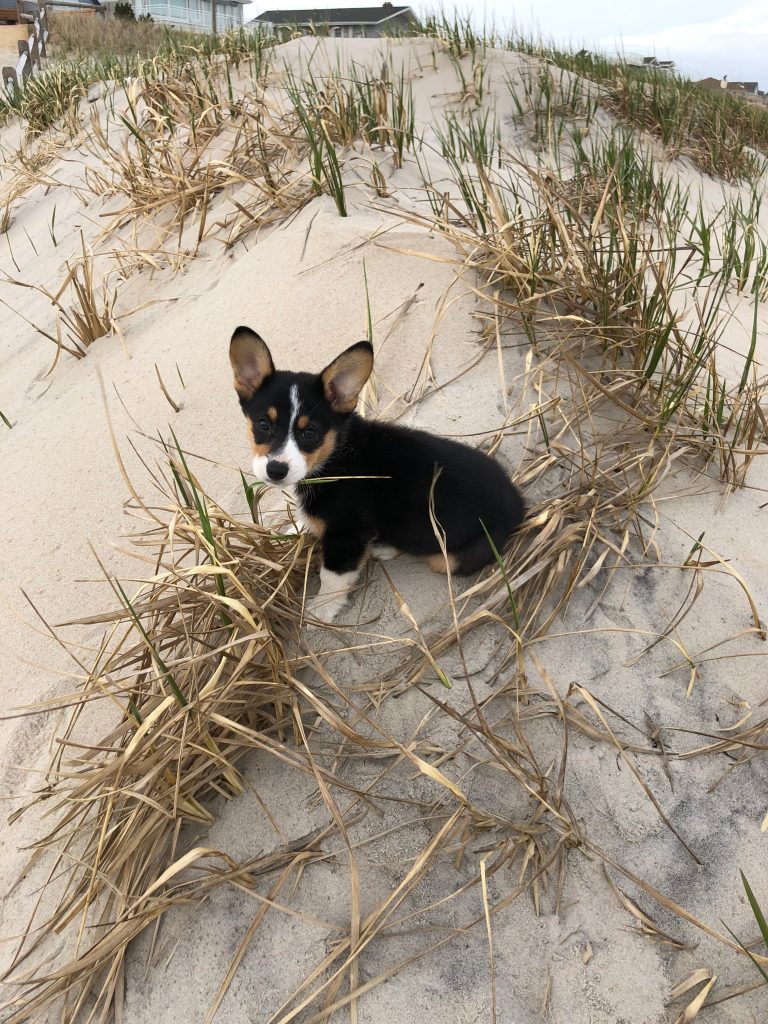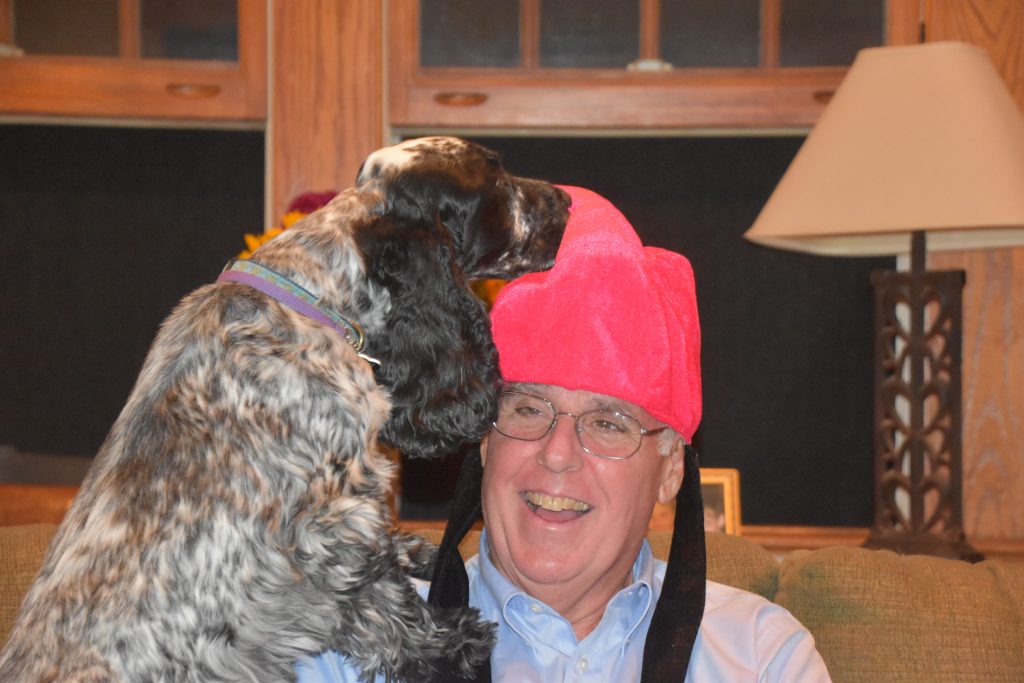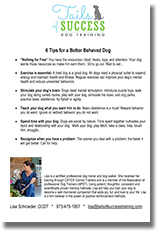Quick Review:
What is socialization? Socialization is introducing your puppy to the world he will inhabit and helping him to make good associations with people, places and things.
Why is socialization so important? Incomplete or improper socialization during a dog’s first 3+ months of life, can increase the risk of behavioral problems later in life including fear, avoidance or aggression. Well socialized dogs are more likely to be well-adjusted, confident, friendly and happy dogs for life.
When do you do it? Because the first 4-16 weeks of a puppy’s life are the period when sociability outweighs fear, this time, called the Critical Socialization Period, is the best window of opportunity for puppies to adapt to new people, animals, and experiences. While the first three months is the most important socialization period in a puppy’s life, owners of puppies that have passed this milestone are strongly encouraged to continue to socialize as much as possible.
How do we do it correctly? Think of this as a time to provide your pup with POSITIVE experiences with NEW things in his environment. The best way to make sure he has a great experience is to be sure to include things he loves, like food, toys and play while you are doing it. If your dog is not having a great time you need to slow down. If your dog is having fun and is happy and comfortable you are doing it right and keep it up!
Seriously??? In case you haven’t noticed, we are all stuck at home???
Got it, here are some suggestions for socializing your pup during these complicated times: Before the tips, it is important for you to understand that although meeting new people and dogs is certainly an important part of the puppy socialization process, there are plenty of other things you can focus on in addition to puppy & people or puppy & dog interactions. Socialization also includes hundreds of experiences your pup will encounter throughout his lifetime. Examples of these encounters include, but are not limited to, handling at the vet or groomer, loud or startling sounds, varied surfaces dogs will walk on while out and about, new smells to be noticed and new sights in the everyday world. Luckily, you can practice most of these things at home. Stop the worry and get to work (or play!); there’s still so much we can do with a little extra effort. Here are some tips on how to continue puppy socialization during these uncertain times.
USING AUDIO AND VIDEO STIMULI
There are many videos on the internet that replicate the same sounds that your puppy may experience outside. Examples include construction noise, fireworks, thunderstorms, smoke alarms, crying babies, honking cars or traffic, skateboard sounds, phone ringing, other dogs barking, trains and sounds of kids playing. Our goal is to expose our pups to these noises so that they are no big deal. Start off by playing these sounds at a level that is barely audible, and day by day if your pup shows no reaction to the sounds, increase the volume. The key here is to watch your puppy’s body language. Your pup’s signals of unease can be subtle and easy to miss. While you’re looking for a loose, wiggly, and enthusiastic puppy, if you’re unsure I can help you identify signs of stress. During the socialization window, exposure isn’t what matters – it’s your pup’s
emotional reaction to new things that matters. Neutral (he does not even seem to notice the sound) or happy and comfortable or even curious without fear (wiggly, turns to look but is easily distracted by a toy or person or anything) is the goal. If your dog shows any signs of fear or stress, then lower the volume and play the sound while he chews a Kong or you toss some treats until he shows you that neutral or happy reaction.
WEIRD MOVEMENT? NO PROBLEM
On top of strange noises, we can expect that pups will have to tolerate all kinds of stimuli coming towards them unexpectedly over the course of their lives. While you can’t bike or skateboard through your home (maybe some of you can in the garage or basement), you do have a broom, a blow dryer, and a vacuum. After your pup shows no reaction to the sounds of these items, you can start working on desensitizing them to movement. Remember to start at a low level and to work your way up. It is better to go slow here than to move too fast and risk your pup developing a negative reaction.
TOLERANCE TO SUDDEN ENVIRONMENTAL CHANGES
We want to be sure your puppy is comfortable with changes in their environment. Now that the environment is somewhat constricted, we have to be creative in making sure your puppy is exposed to changes so he or she will not be overwhelmed when changes happen in real life. Move items in your house when your puppy isn’t looking. Use what you have around the house to create obstacle courses. We then encourage your puppy to explore this “new” environment while ensuring the process is fun! Together, you can find ways to disrupt your environment so that change is a normal part of your puppy’s life.

ALL SURFACES ARE SAFE We want to be sure your puppy is exposed to a variety of walking surfaces to prevent phobias from developing to different floor substrates. We can do this at home by setting up an “obstacle course” that includes things like stairs and mimics different surfaces your puppy will encounter out in the world. You can also take an “empty” puppy who has just gone outside and fully eliminated to various locations inside and outside of your house to expose him to different surfaces (basement, stones, bathroom, garage, driveway, grass, leaves, sand, bathtub, bedrooms, porches/decks…). Your pup should feel comfortable walking on carpet, wood, tile, linoleum, cement, and grates (for this you can lie a gate or crate down and put some toys on it for him to explore).
FROM EARS TO TAILS, EYES TO NAILS
We want to be sure your puppy is comfortable with all kinds of touch, from being picked up to having a bath. You should practice this at home every day. We use what is called conditioning and desensitization to create good associations with uncomfortable things by using yummy treats. When you need to pick up a sleeping puppy, be sure to call his name first and then give him a treat as you pick him up. When you bathe your pup, you can smear some peanut butter or cream cheese on a surface around your kitchen sink or tub so he can lick it while you clean him up. Or, have someone give your pup treats while you touch and massage his sensitive spots (ears, mouth, paws and tail area). Your vet and your groomer will thank you for this practice! Dry your pups paws with a towel when coming in from outside- rain or shine- to help them become more cooperative.
CRATE TRAINING/ALONE TIME IS STILL IMPORTANT
Even though you may currently be at home all day, your puppy still needs a structured schedule to reduce stress on everyone and to let the puppy know what is expected. This is an excellent time to create periods of “alone time” for your pup, like crate and nap breaks. Just because someone (or everyone!) is home with the puppy, doesn’t mean they need to be with the puppy 24/7. Crate breaks, even short ones (5-10 min.), can help the puppy become acclimated to going in the crate and having some alone time, regardless of who is in the house. This is important to help prevent the development of separation anxiety when you go back to normal life. Two easy ways to start are to feed your pup’s meals in the crate or to give the pup a kibble filled Kong in the crate while you shower or do some daily chores.
NEW PEOPLE IS A LITTLE HARDER BUT…
The vast majority of us are now spending time with only our immediate family members so finding ways to “introduce” or “expose” your pup to new people takes a bit of creativity. Rather than thinking of it as introducing your pup to new people, let’s try to expose him to the many “looks” people can have. You and your pup can spend time on your front steps watching as people run, walk, bike, push strollers, skateboard, scooter…on by. Have the members of your household dress in costumes, wigs, sunglasses, hats, boots, mittens, big puffy coats, all white or all black clothing. Different silhouettes can confuse or scare pups so work on that! If you have them available, pull out things like crutches, canes, umbrellas, tennis racquets or even bouncy balls or balloons to expose your puppy to each day. These are things people wear or carry that can be frightening or confusing to dogs if they have never encountered them. Hug your family members, dance around rooms, pretend to limp or shuffle when you are walking, do yoga or other exercise programs that allow your puppy to see you move your body in different ways. These tips should help address some of the concerns regarding the people piece of socialization.
Tails of Success is now offering virtual training options during the COVID-19 outbreak. To schedule a private phone, Skype, Zoom or Facetime session please contact Lisa at 973-479-1967 or lisa@tailsofsuccesstraining.com.


